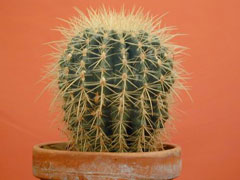


Home
Flowers &
Indoor Plants
Fruits & Nuts
Ornamentals
Vegetables
Special Topics
Resources
Glossary

 |
What about it? There are many different genera and species of plants that are considered to be cacti. Some common cacti belong to the genera Echinopsis, Ferocactus, and Mammillaria. You may also know them by their common names: Easter-lily cactus, Sea-urchin cactus, Fishhook cactus, Devil's-tongue, Lace cactus, and Old-lady cactus, to name a few. True cacti are of the plant family Cactaceae. Most of them are native to the Americas. They are described as "stem succulents", meaning they have swollen stems and special water-holding tissue. They are also identified by the presence of areoles. These are small nubs of tissue from which spines and flowers grow. What is it used for?Cacti are primarily houseplants. The larger cacti are used as specimen plants, especially the ones with the dramatic flowers. Where does it grow? How do we grow it? Cacti have adapted throughout time to survive in incredibly harsh conditions, namely, the very hot and the very dry. They need a well drained soil, but are not particular about the pH. Do not over-water. Even a moist soil is too much water. Cacti need a soil that will flush the water through it. From this brief flushing it will absorb and store the water that it needs. Cacti also need plenty of sunlight. They will tolerate a half-day of shade, but need at least 4 hours of direct sunlight each day. What are its primary problems? Mealybugs can become a problem, as well as scale and spider mites. How do we propagate it? Cacti will germinate from seeds or cuttings.
© Copyright, Department of Horticulture, Cornell University. |
